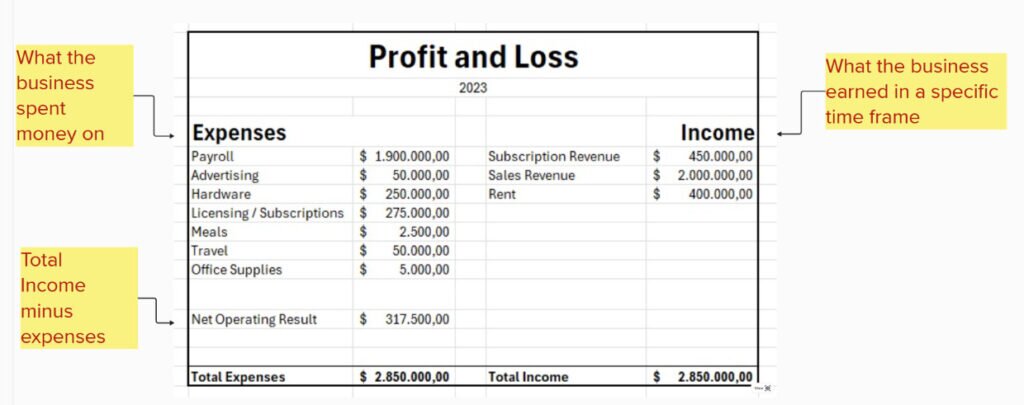Every executive team is focused on the financials. They care about revenue and their organization's financial results. Understanding how to relate the value of what we do in product storytelling to business results and money is a key factor in getting teams funded and being trusted with our roadmap priorities. Ideally, product initiatives make sense strategically AND financially in delivering value to the business.
If we want to get promoted into a senior leadership role in product, we can’t successfully execute this role without a good grasp on what business viability and value to the business are.
There are obviously more dimensions to business viability than just the numbers of the current month: For example, the strategic value of opening a new market or customer segment and compliance topics. This article focuses on how to think about financial numbers in the context of product decisions.
Where to get started
Get started by learning what financial statements are and how our decisions in product impact them. Come up with a basic Business Case Model to use for the evaluation of different initiative ideas. And go find out what Financial metric matters the most in the context of your organization.
What are the main financial statements each CFO typically looks at?
Executive teams typically look at a Balance Sheet, the Profit and Loss Statement (also called Income Statement), and Cash Flow Statements, plus a number of key financial metrics for their regular financial reviews. They also pay close attention to how their financial forecasts (budget) compare to the actual numbers of each month.
In a Balance Sheet, you can see:
- Assets: What the company owns
- Liabilities: What the company owes to somebody
- Equity: The difference between the Assets and Liabilities

A healthy balance sheet has more Assets than Liabilities. When you see liabilities increase while assets do not, you can tell that the company is not in a great place financially. This can, for example, happen when a company owes a lot of money to financial institutions and the interest rates rise.
Which is one of the reasons a number of companies have been struggling with their finances most recently. If your company's products then don’t make enough revenue to cover those interest payments, your CFO might be forced to take a look at expenses they can control: e.g. the money spent on payroll, which can lead to layoffs or hiring freezes.
In a Profit and Loss Statement, you can see:
- Expenses: What the business spent money on
- Income: What the business earned in a specific time frame
- Net operating result: It is the difference between Income and Expenses and either shows up as a Profit (Income higher than Expenses), or a Net Loss (Expenses higher than Income).

Obviously a healthy P&L statement will show more Income than Expenses and a nice Net Profit as a result of everything you’re doing. What is important here is how to shift the numbers:
- Income goes up when we are creating extra revenue: when we make more sales, when we add paying customers, when we reduce churn, when we manage to increase pricing, etc…
A lot of these activities can be a result of something we do in product. - We increase Expenses when we ask for additional people (their payroll cost is an expense), when we need additional servers or when we spend money on GenAI tokens for example. Every time we build a feature that does not increase Revenue, or reduce Cost, we are spending the time (and with it, payroll cost) of a team on something. And this is probably the most important thing to be aware of in product. Staffing a team in a Sprint can easily account for USD 25k per sprint when we’re paying the team a US or UK-based salary.
Your CFO usually breaks these numbers down further.
They will break down the money flow in a Cash Flow statement to see exactly at what point in the month payments come in and go out and that they always have enough Cash in Hand to make payroll payments or payments to suppliers and banks.
They also break the numbers down by what is truly core to the business (revenue generated and directly applicable cost for that), vs. other expenses like interest payments, taxes, or depreciation on assets.
As a result, they arrive at a metric called EBITDA (Earnings Before Interest, Taxes, Depreciation and Amortization). That is a number a lot of CFOs watch closely for two reasons:
- When you are looking to get Funding, Investors will ask for EBITDA growth
- When you are looking to sell your company, a potential buyer typically pays a multiple of EBITDA for the company.
In both cases, anything that leads to more direct revenue and everything that leads to extra cost has a multiplier effect on your ability to get funding or sell your company at a great price.
This explains why sales and marketing (which are typically associated with driving revenue) are so popular and often have so much power in organizations.
When we fail to tell good stories about revenue growth or cost savings as a result of our product efforts, we are seen as a team that merely produces cost (in the form of payroll and other expenses), not as a function that helps us grow the company.
But it is easy for us in product to change the stories we tell our executive team about our roadmap decisions. We do this by first understanding our business model, then making some basic calculations about the initiatives we want to prioritize and then translating these into stories about money.
Business case modelling
Getting a basic business case model in place will help you understand how you can positively impact Revenue (or reduce cost) and also how to think of multiple different initiatives and their financial value to your organization.
I would typically recommend making a quick estimate calculation of revenue impact and cost impact for a period of about three years. Why three years?
Because for most work we do, we first have a heavy cost to pay (the payroll for the number of sprints it takes to get something done) before we can see the effects on revenue increase (or cost savings) later.
For the revenue calculation, start by understanding the following formula for each of your product initiatives:
| How many of what kind of customer (e.g. your ICP profile or your internal customer), do what kind of activity for what sort of financial result. |
E.g. A new feature aims to gain 100 new customers per month that will buy your standard subscription at USD 49. The average Customer Lifetime of a new subscriber is 36 months. (100 customers x USD 49 x 36 months = USD 176000 for every 100 customers gained in a month).
For the cost calculation, think of payroll, and direct related cost (e.g. servers) first:
| How much time and directly related expenses are needed to build and maintain this initiative. |
For example, you need a month to build this new feature set, which means two Sprints at USD 25k each. Within three months, you plan to do one sprint for updates and bug fixes and an additional Sprint of maintenance work in each of the subsequent years.
As you model this out, you’ll see that initially, you’re creating more cost, and only over time will you make relatively more revenue out of this new feature set.
A very basic model based on this example might look like this:

Realistically you’d probably need additional information in there. This currently has no assumption of churn or related server costs.
Sticking with this very basic model, you could also calculate assumptions of growth in sales, which would change these numbers quite a bit over time. With just 10 extra subscribers each subsequent month, the profit increases from USD 41k over three years to USD 316k in this model:

How might you now use this for prioritization decisions and good financial storytelling?
Example of prioritization decision:
Imagine you’d have to justify your idea for the creation of 10 extra subscribers per month vs. the proposal of Mike in sales, who says their deal makes USD 30k in extra revenue one time in the coming month.
While the short-term impact of your work in the three months does not look that great, over time, this will create a much bigger piece of revenue.
What matters now is to be aware of what financial metric your company currently most cares about:
- Imagine you’re two months prior to a possible sale to a Private Equity firm: the 30k Mike can close one time now, will help your evaluation immediately. While your idea will help overall growth in the long run.
=> Time to clarify with your CFO what matter most now: Immediate Profit or Long Term Growth - Imagine you just got funded and need to show substantial growth in the coming three years: your idea carries way more benefit than the one-time 30K deal Mike is looking to close next month.
Remember when I initially said that you should talk to your finance team to find out what numbers matter? Here is what I suggest you do:
| Talk to your finance team and ask:What key financial figures are we watching right now and why?Is our focus on growth or profitability right now?What Business case in terms of revenue growth or cost savings would excite you?Can you take a look at my Business Case template and help me understand if my calculations make sense or if something important is missing? |
By going to your Finance team and asking them these questions you build trust and credibility. It shows them that you care about the business impact of your prioritization decisions. And it is a great way to say “no” to requests for features or work pieces that have no business or strategic impact.
The financial story to tell could sound like this:
This business case will result in USD 41K over three years without any user growth, but could deliver as much as USD 316 if we manage to sell 10 additional subscriptions based on this. We know that 250 people per month actively ask for this through our red door test, so this seems like a conservative estimate.
Remember, though, that using the numbers for prioritization decisions or, for example, asking for funding for extra people always plays within the larger context of your company's financial situation. That is why it is so important to understand and have good rapport with your Finance team. Ultimately, you’re all sitting in the same boat as an organization that has to be profitable enough to pay all its expenses and reach its next funding or exit goal.
__________________________
If you’d like to learn more, get access to a simple business case template, or want somebody to take a look at your initial business case model, feel free to reach out anytime!







